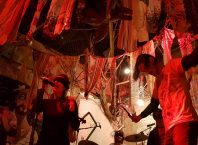I have always been fascinated by anachronisms. And, while I have richly enjoyed seeing or experiencing survivals from an earlier time—like brooding over a cup of coffee in an authentic chrome and glass diner, its décor unchanged since the late 1940’s, or meeting a fellow who writes lengthy books not with a computer or even a typewriter, but rather with a Mount Blanc fountain pen—I am especially interested in things that appear way before their time. I’m referring to events, fashions, styles, or inventions that occur sometime in the past, which we would normally associate with a later period in history. For reasons beyond my comprehension, I get an intense kick out of reading about mechanical “computers” built in the 19th century, experiments in photography in the 1700’s, and oddities like a 1934 film called Transatlantic Merry Go Round, which included a song called “Rock and Roll.”
Consider this: My all time favorite book about New York devotes several pages to Bleecker Street in Greenwich Village, which the author calls the “headquarters of Bohemianism.” “Walk down it almost any hour of the day or night,” the author informs us, “and you will see many things that are new to you. Strange characters meet you at every step; even the shops have a Bohemian aspect…That long-haired queerly dressed young man, with a parcel under his arm, who passed you just then, is an artist, and his home is in the attic of that tall house from which you saw him pass out.” The book: Lights and Shadows of New York Life; or, Sights and Sensations of the Great City by James D. McCabe, Jr. And while the author could certainly be describing Bleecker Street as it appeared in the 1950’s and 1960’s, the date of publication of this book was…drum roll, please…1872.
And then there is the story about a really special 4th of July weekend in Hollister, California. On that date a number of years ago, a motorcycle gang called the Boozefighters rolled into town—with their girl friends hanging onto their backs—and took the place over. They filled the bars—after driving their motorcycles through the front doors and plate glass windows—drank, partied, brawled with the townsfolk, and began racing their Harley-Davidsons and Triumphs up and down the town’s main street. The Boozefighters were soon joined by other gangs with names like the Yellowjackets and the 13 Rebels. Before long there were several hundred motorcycle gang members in town, roaring through the streets on their bikes, skirmishing with each other, tearing up the bars and terrorizing the local citizens. For the entire 4th of July weekend, the bikers owned the town. The Hollister police force, outnumbered and completely intimidated, called in reinforcements from neighboring California communities, who battled the gangs and eventually ran them out of town—but not before they attracted the attention of the media. Reporters and photographers, from a San Francisco newspaper and a national magazine, converged on Hollister to document the carnage. The newspaper photographer was particularly taken with the Boozefighters’ “chics,” and took numerous pictures of girls in tight jeans, tight T-shirts, and tough expressions on their faces. The national magazine featured several photos, the most famous being that of a beefy member of the Boozefighters, in black leather jacket, motorcycle cap, and gang colors, perched drunkenly on his Harley-Davidson, waving a can of beer. The year? Brace yourself: it was 4th of July weekend, 1947. If you are somewhere in your late 20s or 30s at present, these people were the age of your grandparents.
Jewish history abounds with events that occurred way before they were supposed to, especially here in Israel. One particularly fascinating story is that of a large aliyah of Ashkenazi Jews to the Holy Land in 1700—the first significant, organized migration to Israel of Jews from Europe in history.
In the 16th and 17th centuries, small numbers of Jews from Europe had immigrated to Israel, as individuals and in family groups. Among the most illustrious of these was Rav Isaiah Horowitz who, by the time he had decided to make aliyah in 1620, had already served as the chief rabbi of Dubno, Ostraha, Frankfurt-am-Main and Prague. From these pulpits, Horowitz had argued that the coming of the messiah and the redemption of the Jewish people would not occur until the Land of Israel was settled; he saw his own aliyah as a step in the right direction. And yet, while Horowitz wrote to the communities of Eastern Europe of a Jerusalem that “is a large city like Krakow, and every day large buildings are added to it and it is filled with people,” and expressed the hope that the number of Jewish immigrants would swell in the wake of his own arrival, only a handful of European Jews followed his example and made aliyah.
Then came the great Cossack uprising in 1648, and the resultant violent destruction of hundreds of Jewish communities across Poland and the Ukraine. The despair that seized the Jews of Eastern Europe following the Cossack massacres made many turn toward Shabbatai Zvi, the false messiah of Smyrna, whose followers wandered throughout Poland, attracting large numbers of converts. One such group of converts to Shabbateanism was led by Rav Judah Chasid of Dubno, an extremely charismatic figure who, in the last decade of the 17th century, had already acquired a substantial following. A spellbinding orator, Rav Judah Chasid exhorted his enthusiastic audiences to ever greater degrees of fasting and penance, convinced that these, along with certain cabalistic rites, would bring about the redemption. By the year 1698, Rav Judah Chasid and his followers were referring to their group as “Chasidim.” By interesting coincidence, this name was later to grace the movement led by the Baal Shem Tov, born in Poland that very year.
Increasing messianistic fervor, along with persecution by the Krakow rabbinate who wished to rid the area of followers of Shabbatai Zvi, led Rav Judah Chasid to gather up his group and lead them out of Poland to the Land of Israel. They trekked out of Poland in late 1699, and in every German city they passed through, they urged Jews to perform acts of penance, to fast, and to join them in their journey to Israel. Estimates vary, but records indicate that upwards of 1,500 Jews followed Rav Judah Chasid to Israel, arriving in Jerusalem in October 1700.
Unfortunately, the story of this first “mass aliyah” of Ashkenazi Jews to Israel did not end happily. Rav Judah Chasid died one day after their arrival, leaving his 1,500-odd “Chasidim” traumatized, bereft of leadership, and helpless. Expecting redemption, the group found only hardship and despair. Shunned by the local Jewish community, who rightly suspected these newcomers from Poland of Shabbatean sympathies, the group quickly fell apart. Many followed the earlier example of Shabbatai Zvi and converted to Islam. Others—like Rav Judah Chasid’s nephew—accepted baptism and became Christians. The rest scattered, many returning to Poland.
The good news is that although unsuccessful, the journey of Rav Judah Chasid’s “Chasidim” to Israel soon inspired others from Eastern Europe to make aliyah. Virtually all of these early pioneers were driven by religious fervor. The Baal Shem Tov himself planned to come to Israel, and in 1733 visited a wealthy family in Slutzk to arrange financing for the trip. Although the Besht never made it to Israel, many others from his time did. In a letter to the Diaspora in 1741, the scholars of Jerusalem were able to report that upwards of 10,000 Jewish people were living in the Holy City.
Now tell the truth, wasn’t that interesting?
Image credit: foonus
http://www.flickr.com/photos/foonus/2182727348/in/photostream






As soon as they create a Nobel prize for blogging I’m a sure your name will be will be on the shortlist
My God, what a brilliant article. Such knowledge! Such writing! Such masterful use of the English language. I read the piece through tears of joy and wonder! I smell a Nobel Prize for Literature, coming to this incomparable genius, this gift of God to journalism, very soon!
Comments are closed.